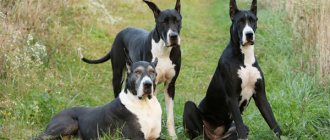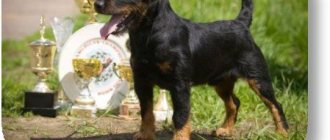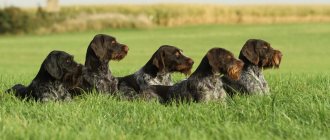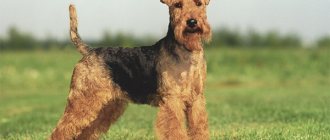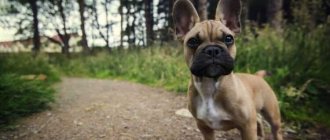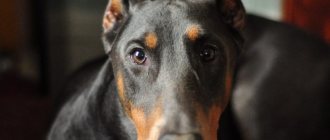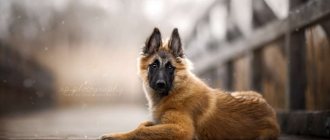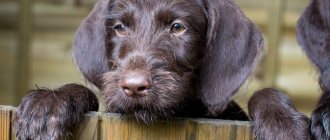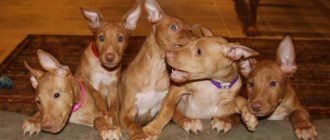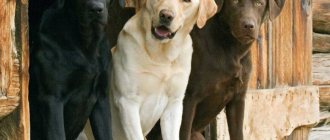Smart, resilient and loyal! These are the three main characteristics of the dog breed that we will talk about today. Such a dog can become your faithful companion, friend and invaluable assistant on the hunt. We won’t torment you for long – the handsome drathaar is worthy of these compliments. The dog is one of those who can hardly be called capricious. With proper attention to your pet, hunting with a drathaar will become a real adventure and exciting event. Remember that training a drathaar should begin in the first months of its life. If everything is done correctly, training a Drahthaar will not require any more effort than working with a representative of any other breed. Let's start our conversation with how to choose a Drahthaar puppy for hunting.
Features of the psyche of the drathaar
Training a drathaar at first glance is not a difficult matter, since initially we are talking about an intelligent animal, in which the instinct of a hunter and endless devotion to the owner are inherent in nature. However, when starting to train a drathaar, it is necessary to take into account the peculiarities of his psyche and character, so as not to provoke fears, neuroses and various kinds of negative behavioral manifestations. The animal by its nature has a calm, even disposition and a high tendency to learn. All that is required from the trainer is to develop the instincts inherent at the genetic level and get the dog to understand what and why to do while hunting.
Drathaar
As can be clearly seen from any video of a hunt with a drathaar, the dog is sensitive to the owner’s gestures and is capable of tracking prey, as well as announcing. The earlier the dog’s training begins, the more effective and easier it will be to prepare him for work. At the same time, when raising an animal for bird hunting, one should not rush, since premature contact with game can frighten or provoke aggression unusual for the breed.
Each science has its place and time...
You should start training your pets at eight to eleven months. By this time, the young dog should have learned all the necessary commands. The animal's physical reserves will also be at the proper level.
Ambitious dog owners strive to introduce their puppy to the “hunting extreme” as early as possible. Some hunters are proud that at six months the puppy has already pleased them with competent crawling, and at eight months it has brought its first prey. Their delight is understandable. But too early, exhausting training can undermine the puppy’s strength. It would be wiser to pay attention to the general preparation of the pet.
How to overcome fears
Drathaar training will become impossible if the dog is afraid of its owner or external phenomena, such as a body of water, the noise of a shot, a loud shout, etc. It is good if the puppy shows fearlessness from birth and readily rushes into the water and adequately reacts to the sounds of gunfire and given commands. However, this does not always happen, and in order to teach an animal to fetch a duck that has fallen into a lake, you will have to teach the dog to overcome its fear of water.
So, long before you start training your dog to catch a bird, you should devote time to training, during which the dog will have to fetch objects from the water. It is advisable for the owner to walk through the shallow water, demonstrating the absence of danger, and sit on the shore, waiting for the animal to come closer. The dog's attempts to enter the water should be rewarded with treats, play and affection. Later, the owner can go deeper into the water and swim with the puppy until he feels confident.
Here, under no circumstances should you use force and coercion, as this is a direct path to the development of neurosis. In video recordings of hunting, one can often observe that a dog, frightened by the sound of a shot, gets lost and does not immediately begin to pursue the prey. Often because of this, the hunter loses a wounded animal or cannot find game that has fallen into the water. To avoid this, the puppy must get used to sharp sounds and learn not to react to them, continuing to follow the owner’s command.
Who should track the bird, who should chase the wild boar...
An inexperienced person, when getting a hunting dog, dreams that his pet will turn into a universal hunter. But this is a utopia. When purchasing a husky or a greyhound, you must plan what kind of animal you expect to hunt with your pet.
As a rule, huskies help hunt dangerous and large animals (moose, wild boar). But the first object of pursuit for these dogs is the squirrel. More and more often, dog breeders are interested in how to train a husky. Are there any secrets associated with the character of this dog? Handling a pet of this breed is not too difficult.
You should remember a few rules:
- The principle of imitation works well for the husky. Therefore, young animals are trained in the company of an experienced bitch.
- You cannot force a dog to chase a large animal. The student who refused to follow the boar may prove herself brilliant in the process of hunting a fox.
- From an early age, you should train your pet to give you its prey. The dog must understand that it is forbidden to bite or torment a killed sable or hare.
There are certain difficulties associated with training inexperienced retrievers. Since retrievers are impressionable and somewhat melancholic, harsh treatment of them is unacceptable.
Technique for training a drathaar on different types of prey
Training a dog to hunt a bird is different from training a dog to hunt a hare, and it will be better to focus your efforts on developing skills in one area. Subsequently, when the dog becomes experienced and begins to understand its owner better, it will be possible to expand the range of game, but at first there is no need to scatter, especially since both methods are specific. A video course on training hunting dogs always contains only general recommendations, without taking into account the fact that each animal is individual and has its own unique character traits and characteristics, without which success cannot be achieved.
Training takes about a year and the optimal age for serious training is considered to be 6-7 months, when all preventive vaccinations have been completed and the process of changing teeth has been completed. It is pointless to start training after two years, since the favorable age has been missed, and all efforts will be in vain. Before training, the dog must be absolutely healthy, calm and not overfed. In addition, good emotional and psychological contact with the owner is important.
Drathaar
The easiest way to train an animal to hunt a duck, since a hare is too difficult a prey for a young, inexperienced dog, although this remains at the discretion of the breeder and depends on his personal hunting preferences. For classes you will need accessories such as:
- durable collar;
- convenient pouch for treats;
- long, at least 3 meters, strong leash;
- anti-tick spray;
- special whistle.
Learning to hunt a hare occurs in several stages. At the first stage, the shuttle is practiced, the dog is taught to take stances and track prey. Next, they achieve a calm reaction to the target, excluding its pursuit until the “Aport” command is received. And finally, the training ends with work in the field, where at first the emphasis is on forcing the animal to maintain its stance and not chase downed or startled game.
Despite the fact that training a drathaar on a hare or bird is a complex process that requires knowledge, experience and a systematic approach, sending your pet to dog handlers for training is not the best solution. During the hunt, it is important that the dog unquestioningly obeys and understands its owner, and the easiest way to achieve this is through training, which should begin from the first weeks of the puppy’s life, developing the instincts inherent in nature. A training video, special literature and expert advice, as well as the desire to achieve mutual understanding with a four-legged friend and patience, are perfect to help a novice dog breeder.
Did you like it? Share on social networks!
We recommend reading
- Features of Jagdterrier training
- Beaver hunting with a gun - beaver habits and hunting features.
- Developing the hunting instinct of the shorthaired pointer
- ← Walkie-talkies used in hunting: what are their features, which ones are better and which ones to choose?
- Hunting binoculars: types, features, how to choose? →
The “no” command: for whom is it relevant?
It's no secret that dogs often get injured and die during hunting. Fate is not the only one to blame for this. Lack of training for four-legged helpers can play a fatal role at any moment.
Even inexperienced dog breeders know the importance of commands. A mature hunter in his instructive conversation will probably say that unquestioning execution of the “no” command can save the life of your pet during testing.
When thinking about how to train a hound, analyze not only the dog’s behavior, but also your own. Are you always consistent in rewarding your dog for a well-executed command? Do you refrain from punishment under the hot hand? In order for the dog to feel a brave leader in your face, you must not give in to panic and irritation.
Do not exhaust your puppy with too long lessons. Otherwise, the animal will perceive your training tricks as violence against itself.
Comments
- Andrey 05/23/2015 at 15:43 I have been reading about this breed for a long time. and I increasingly want to buy a drathaar for hunting hares. But in my city there is not much choice among breeders. And most without pedigree. Is the pedigree so important for this dog? Or can I myself raise the puppy to be an excellent hunting assistant?
Reply Elena. 10/23/2015 at 10:49Hello Andrei. Any puppy must be taken with a pedigree, especially the Drathaar. Without documents, you will not be able to evaluate the dog’s appearance at exhibitions or take part in hunting dog competitions. When they buy a puppy from us, almost everyone tells me it’s only for hunting, and when they come to choose, they take the most beautiful puppy. As a rule, puppies without documents may not be purebred, and when they are babies this cannot be immediately determined. You can raise a puppy yourself, there is a lot of literature and the main assistant is the Internet, watch the training video. At the moment we have Drahthaar puppies in our kennel. Contact number 89109335724.
Answer
Dear Andrey. Transforming a puppy into a cop is a very serious question that requires you to understand for what purpose the puppy is being purchased. Hare hunting requires from you not only desire but also experience in setting up a cop. My advice is to contact the regional section of cops, gain knowledge via the Internet, find an experienced handler .
Answer
I adopted the Drathaar puppy because of my son. The child really liked the puppy, my husband and I consulted and decided to take it, even though before that we had a Labrador and we don’t have any hunters; naturally, we don’t own a Narva hunting dog, not to mention Drathaar. We've had the puppy for almost a month. They took it without a pedigree, the owner did not record the mating, even though both parents had an excellent pedigree and both were excellent hunters. Our girl is very smart despite the fact that she is only 4 months old. She covers commands on the fly, is easy to learn, and apparently she inherited the hunter’s instinct from her parents, picks up the scent perfectly, senses prey from a distance. Especially chickens :-)) Now my husband and I perfectly understand the words of the embryo - Well, now you will have to become hunters))). And it’s true that the husband begins to switch from fishing to hunting. I want to say that Drathaar is not only an excellent hunter, but also an excellent, devoted friend, an excellent guard, and no matter how crazy it may sound, he is also an excellent nanny. She plays wonderfully with children and with each child in different ways, studying character, and even the child herself. And leaving her at the store with the stroller, she did not allow anyone to approach the child, grinning angrily and growling while looking into the stroller to see if the child had woken up. I recommend this breed to everyone, not only hunters but also people who love animals!
Answer
I like the cool breed of dogs.
Answer
Add a comment
latest comments
Alexey: How can I order?...
Vladimir: The material is outdated and requires correction on two points: - described ...
Mikhail: Is it possible to make a module for Muscovite heels? How much will it cost …
Gennady: One person did something and everyone else should be responsible for it...
: If he opened fire within the city, then this is not a hunter, but a idiot...
Anatoly: In the requirements for documents for renewal, replace the psychologist with a psychologist...
YuryY: Having shot 1 can of gunpowder, Bars was very pleased with it, the factory weighed it...
Acorn: You understand so much...
: Vile degenerates! Bastard hunters, cowards, shoot yourself and that’s it...
Alexander: 35g, it’s simply impossible to stuff it into a pistol cartridge. People, for example...
Vladimtr: No, it’s not a typo, it says 35 g of Gunpowder per bullet weighing 7.45 g of gunpowder...
Evgeniy: It’s not clear. But for a state fee of 650 rubles, can I buy pheasant and...
Survey
School of life for four-legged hunters
Special areas are allocated for training four-legged hunters. When planning to take your hounds to the instructor, take with you high-quality pet food, as well as leashes and collars. The duration and cost of training should be discussed in advance with a specialist.
Some trainers offer owners the following dog training scheme:
- The first lesson is conducted in the presence of the owner.
- At the end of the trial lesson, the instructor points out the strengths and weaknesses of the dog's temperament.
- The dog and its owner are given “homework.”
- For six to seven days, the owner works with his ward without an instructor.
- The teacher is again conducting a lesson with the young hunter.
A hare is usually used as a “decoy duck” to train a hound. The instructor encourages the dog to chase the animal, to drive it away. It is not a fact that the first lesson with a hound will end with a triumphant catch of the long-eared animal. But the pet’s innate skills will “shake up.” A specialist will be able to improve them and direct them in a direction favorable for hunting exploits.
If you have experience with dogs, train the hound yourself. When the prey is caught, train your pet to immediately give it to you. Reward your assistant with goodies.
The dog's wayward behavior should prompt you to take a more balanced approach to the training process. Invite your senior colleague or fellow game warden to a training event. Let the “judge” look from the outside at your pet’s efforts and at how you give commands. Perhaps the observer will give you timely instructions.
On average, training a smart hound lasts four weeks.
Dog health
Strong and hardy, drathaars are still predisposed to the following diseases: hip dysplasia, otitis media, diabetes, von Willebrand disease, eye diseases, dermatitis and eczema.
It is imperative that your pet is promptly treated for internal parasites and vaccinated.
Protection against external parasites such as fleas and ticks also requires special attention. During the season of increased tick activity, it is necessary to protect the animal with anti-flea collars and sprays.
After each hunt, you need to additionally examine your pet to make sure there are no ixodid ticks, carriers of terrible diseases.
Vaccinations
Drahthaar puppies need active walks, love to run and spend a lot of time outside. Therefore, vaccinations are extremely necessary for them.
The very first one is done at the age of 6 weeks. Then after 30 days, at 6 months and at 1 year. On the eve of the procedure (about 2 weeks), the puppy is given anthelmintic medications. After vaccination, the baby may not feel well, but after 2-3 the illness goes away. Each time after vaccination, the pet must be kept in quarantine for 2 weeks - not allowed outside and not allowed to communicate with other animals. Once the dog reaches one year of age, vaccinations are given annually. This will significantly increase your pet's chances of a long and happy life.
Greyhounds: nuances of temperament
The character of a greyhound can be called a real gift for a hunter. Perseverance, courage, “dosed” anger – this is what a pursuing dog needs. The animal's physical attributes are also inspiring. But it should be understood that greyhounds are animals with increased excitability.
Experienced hunters advise teaching greyhounds to work in pairs or in a trio format from an early age. Therefore, you should make sure that the puppies do not show aggression towards each other.
https://www.youtube.com/watch?v=10OjOBbO9Ik
Puppy care
The Drathaar is an unpretentious breed. It is suitable both for keeping in an apartment and in the courtyard of a country house. Before buying a puppy, you need to prepare a place for him where he will be cozy and comfortable. You will need two bowls - for feeding and for water. Containers should be purchased that are heavy and stable so that he cannot turn them over. Toys will also come in handy - with their help, the pet will quickly adapt to new conditions.
Keeping Drahthaar dogs does not take much effort and time. Puppies also don't require much attention. All you need to do is regularly take your baby for intensive walks, provide him with a balanced diet and keep his coat clean. Washing dogs is recommended only in exceptional cases. Their fur has a unique ability to self-clean. But it is necessary to comb it (especially during the molting period) as often as possible.
History of the breed
The Drathaar, or German Wirehaired Pointer, is a breed of pointing hunting dog, bred in the 19th century in Germany. Pointing dogs are dogs that have an innate tendency to stand up to game. The name of the breed comes from the German words "draht", which means "wire" and "haar", which translates as "hair".
In the second half of the 19th century, due to the collapse of the feudal system in Germany, extensive publicly accessible hunting grounds were formed. Emerging at the same time, in the process of industrialization, the German middle class began to hunt in these hunting grounds and needed a new breed of hunting dogs. This new breed of dog had to be multifunctional, capable of working effectively in a wide variety of, often difficult, natural and climatic conditions. The new breed of dogs had to be hardy, have an excellent sense of smell and be able to work on a wide variety of types of game.
To create a new breed of hunting dog, German hunters used the blood of existing dog breeds: Airedale Terrier, Griffon Korthals, Poodle Pointer. In addition to these, the following people took part in the creation of the German Drahthaar: English pointers and setters, the water poodle, as well as breeds of mountain herding dogs. Among modern breeds of hunting dogs, the closest relatives of drathaars are shorthaired pointers and langhaars.
Drathaars, as a breed of hunting dogs, have absorbed the best working qualities of their predecessor breeds: great physical strength, endurance, and hunting passion. A characteristic feature of the Drahthaar that distinguishes it from other breeds of hunting dogs is its coarse, stiff coat. It is the drathaar's wool that explains many of its good working qualities and ability to work in adverse conditions.
Recognition of the Drathaar as an excellent breed of hunting dog came to them among German hunters in the 70s of the 19th century. In 1902, a club for lovers of the German Drahthaar breed was founded in Germany. In 1924, the breed was officially recognized at the world level by the International Canine Federation. Gradually, the recognition and popularity of the drathaar spread across the European continent, including Great Britain.
In the United States, Drahthaars appeared in serious numbers in the post-war years, and the breed was recognized by the American Kennel Club in 1959. Initially, the Drathaar was not particularly popular among American hunters, who were accustomed to more highly specialized breeds of hunting dogs, but gradually the Drathaar gained recognition among them as well.
Nowadays, work is still underway with the Drathaar to breed and improve the breed qualities of these wonderful hunting dogs. The Drathaar is one of the most famous breeds of pointing dogs in the world. Every year the popularity and number of drathaars in our country is growing.
Education in the first months
First of all, the owner of a drathaar should understand that raising a child and raising a dog are completely different things. The child will imitate and repeat the actions of his father or mother, and the puppy must understand what is required of him at the level of instincts and habits.
From the first months, a drathaar puppy should begin to be taught not so much to commands, but to ensure that it grows up fearless. Fearlessness of water and loud sounds, lack of fear of dense thickets - these are the things that you should first pay attention to.
This can only be achieved with complete mutual understanding and patience on the part of you, that is, the puppy’s owners. Training to overcome fear of water often requires considerable effort. Drathaar is very good when it comes to duck hunting. Some owners boast that their dog immediately climbed into the water without any fear. Well, we can consider them lucky. But what to do when the dog completely refuses to even go near the water, let alone get into it?
Training in such cases can become a certain difficulty for the owner. You need to remember that no brute force or shouting at your pet should be used. Only tenderness, praise in the form of treats or stroking, but not screaming and, God forbid, blows. For example, you can simply go to the shore of a pond and sit down next to it.
The puppy will explore the world around him and will definitely come to the water. It is quite possible that he will immediately become a little scared. You should not interfere with him, let everything happen according to his will. Such trips to a pond will first accustom him to the simple understanding that there are still “wet” places in the world. When the puppy grows up, you need to teach him to go into the water. Don’t expect him to swim across a river or pond with the first training, and even bring you a ball. Go into the water about knee-deep and call the puppy to you. If it fits, praise it; if not, stay in the water for a while.
Drathaar needs time to get used to it, to understand it. When the dog begins to enter the water without fear, go into the water a little further and call the puppy. Sometimes you don’t even have to call - the smart and loyal drathaar will rush after its owner.
Accustoming your dog to the sound of a gunshot is the most important step. If a drathaar instinctively senses that it should stalk, stalk, or fetch prey, it has no information in its genes for loud stimuli.
Dog appearance (standards)
Dimensions
Drathaars are large dogs, their height ranges from 57 to 68 cm (males are slightly larger and taller than females). The weight of the animal is from 23 to 34 kg.
Wool
The dog's fur is very hard, wire-like, and fits tightly to the body. There is a waterproof undercoat.
Photo: https://pixabay.com/photos/german-wire-haired-pointer-dog-4012453/
Representatives of the breed have a beard and well-defined eyebrows.
Colors
The coat colors of the breed are as follows: brown, brown-mottled, black-mottled, silver-gray.
Dogs with a solid color must have a patch of white on the chest.
Head
The head is elongated, wedge-shaped, dry.
Teeth and jaws
The Drathaar dog has a scissor bite and strong, close-fitting teeth.
Eyes
The animal's eyes are small and not set very deep. The standard is dark brown eye color.
Drahthaar puppies may have a light eye color, but this will certainly darken over time.
Body and limbs
The physique of the breed is characterized by well-developed muscles. The dog has a deep chest, a strong back, and a tucked belly. The limbs are strong, muscular, smooth.
Tail
The thin tail is usually kept parallel to the ground, as if continuing the line of the back. It may be slightly raised, but is never in an upright position.
Photo: https://sobaki-pesiki.ru/dratxaar-opisanie-porody.html
It is more appropriate for hunting dogs to have their tail docked, which is usually done in those countries where docking is not prohibited by law.
Rock defects
The following are considered defects:
- hunched back;
- high butt;
- narrow or barrel-shaped hind limbs;
- rare wool;
- misalignment of the jaws;
- eyes of different colors;
- taillessness;
- fear of gunshots;
- aggressiveness.
Feeding
Drahthaar puppies eat the same as other breeds. In the first 3 months of life, the basis of their diet is dairy products. Be sure to add some beef, vegetables, and cereals to them. Food should be warm and semi-liquid - porridge, meat and fish soups with vegetables and cereals. Diet diversity is encouraged. You should not give your puppy fatty, spicy food. Garlic, pepper, and tubular bird bones, which can damage the esophagus, are contraindicated. Puppies at this age need to be fed at least 5 times a day. After he eats, the bowl of food is removed. The dog should have only clean water available at all times.
As the puppy grows, the number of feedings per day is reduced, while the volume of food is increased. So, at six months of age, food is given 3 times a day. And by ten months they are switched to two feedings a day. The Drahthaar puppy should be provided with the vitamins and microelements necessary for growth and proper bone development. For this purpose, fish oil, sodium glycerophosphate, and the drug “Tetravit” are added to food.
What else should you feed your drathaar puppy? Industrially produced dry food is the most practical to use. It is only important that it be of the highest quality, since its health, activity, mood and coat condition largely depend on the diet of a Drahthaar puppy. Premium ready-made dry food contains all the nutrients and vitamins necessary for the full development of the baby. The packaging usually indicates what breeds and ages the product is intended for. Therefore, it is always possible to choose the appropriate option for a particular dog. As a rule, high-quality food cannot be cheap. It is not recommended to immediately buy a large bag. It is better to start by purchasing samples of different varieties to choose the one that your puppy will like the most. Approximately every 3 months, the variety must be changed so that the food does not become boring.
